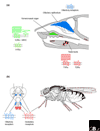Taste and pheromone perception in mammals and flies - PubMed (original) (raw)
Review
Taste and pheromone perception in mammals and flies
Hiroaki Matsunami et al. Genome Biol. 2003.
Abstract
The olfactory systems of insects and mammals have analogous anatomical features and use similar molecular logic for olfactory coding. The molecular underpinnings of the chemosensory systems that detect taste and pheromone cues have only recently been characterized. Comparison of these systems in Drosophila and mouse uncovers clear differences and a few surprising similarities.
Figures
Figure 1
The location of chemosensory organs in the mouse and Drosophila. (a) A sensory neuron in the olfactory epithelium of mice expresses one of about 1,000 olfactory receptors. Neurons in the apical and basal layers of the vomeronasal organ express distinct, unrelated classes of G-protein-coupled pheromone receptors (V1Rs in the apical and V2Rs in the basal layer). In addition, a small family of MHC class I-like molecules is coexpressed with V2Rs in neurons of the basal layer. The taste cells in the tongue, palate and pharynx express other classes of GPCRs, one encoding sweet-taste receptors (T1Rs) and one encoding receptors for bitter compounds (T2Rs). Note that V1Rs and T2Rs are related to each other, as are V2Rs and T1Rs, respectively. (b) The olfactory neurons of Drosophila are located in two pairs of appendages in the head, the third antennal segment and the maxillary palps, and each neuron expresses very few, possibly just one, of the 61 olfactory receptor genes identified so far. The gustatory or taste sensory neurons are located in numerous organs, including the two labial palps on the head, internal sensory clusters in the pharynx (not shown), all the legs and the anterior wing margin. Each neuron expresses a few, possibly just one, gustatory receptor gene. A few gustatory receptor genes are also expressed in olfactory neurons of the antenna and maxillary palps.
Similar articles
- Neurobiology of the gustatory systems of Drosophila and some terrestrial insects.
Singh RN. Singh RN. Microsc Res Tech. 1997 Dec 15;39(6):547-63. doi: 10.1002/(SICI)1097-0029(19971215)39:6<547::AID-JEMT7>3.0.CO;2-A. Microsc Res Tech. 1997. PMID: 9438253 Review. - Taste and pheromone perception in the fruit fly Drosophila melanogaster.
Ebbs ML, Amrein H. Ebbs ML, et al. Pflugers Arch. 2007 Aug;454(5):735-47. doi: 10.1007/s00424-007-0246-y. Epub 2007 May 1. Pflugers Arch. 2007. PMID: 17473934 Review. - Family of bitter taste receptors found.
Barinaga M. Barinaga M. Science. 2000 Mar 24;287(5461):2133-5. doi: 10.1126/science.287.5461.2133. Science. 2000. PMID: 10744529 No abstract available. - Taste perception: Drosophila - a model of good taste.
Stocker RF. Stocker RF. Curr Biol. 2004 Jul 27;14(14):R560-1. doi: 10.1016/j.cub.2004.07.011. Curr Biol. 2004. PMID: 15268874 Review. - Pheromone perception and behavior in Drosophila.
Amrein H. Amrein H. Curr Opin Neurobiol. 2004 Aug;14(4):435-42. doi: 10.1016/j.conb.2004.07.008. Curr Opin Neurobiol. 2004. PMID: 15321064 Review.
Cited by
- HisCl1 regulates gustatory habituation in sweet taste neurons and mediates sugar ingestion in Drosophila.
Kim H, Zhong Z, Cui X, Sung H, Agrawal N, Jiang T, Dus M, Yapici N. Kim H, et al. bioRxiv [Preprint]. 2024 May 8:2024.05.06.592591. doi: 10.1101/2024.05.06.592591. bioRxiv. 2024. PMID: 38765964 Free PMC article. Preprint. - Expression and Functional Activity of the Human Bitter Taste Receptor TAS2R38 in Human Placental Tissues and JEG-3 Cells.
Wölfle U, Elsholz FA, Kersten A, Haarhaus B, Schumacher U, Schempp CM. Wölfle U, et al. Molecules. 2016 Mar 3;21(3):306. doi: 10.3390/molecules21030306. Molecules. 2016. PMID: 26950109 Free PMC article. - Octopamine neuromodulation regulates Gr32a-linked aggression and courtship pathways in Drosophila males.
Andrews JC, Fernández MP, Yu Q, Leary GP, Leung AK, Kavanaugh MP, Kravitz EA, Certel SJ. Andrews JC, et al. PLoS Genet. 2014 May 22;10(5):e1004356. doi: 10.1371/journal.pgen.1004356. eCollection 2014 May. PLoS Genet. 2014. PMID: 24852170 Free PMC article. - Chaperoning G protein-coupled receptors: from cell biology to therapeutics.
Tao YX, Conn PM. Tao YX, et al. Endocr Rev. 2014 Aug;35(4):602-47. doi: 10.1210/er.2013-1121. Epub 2014 Mar 24. Endocr Rev. 2014. PMID: 24661201 Free PMC article. Review. - Genetic architecture of olfactory behavior in Drosophila melanogaster: differences and similarities across development.
Lavagnino NJ, Arya GH, Korovaichuk A, Fanara JJ. Lavagnino NJ, et al. Behav Genet. 2013 Jul;43(4):348-59. doi: 10.1007/s10519-013-9592-z. Epub 2013 Apr 6. Behav Genet. 2013. PMID: 23563598 Free PMC article.
References
- Hall JC. The mating of a fly. Science. 1994;264:1702–1714. - PubMed
- Stocker RF. The organization of the chemosensory system in Drosophila melanogaster : a review. Cell Tissue Res. 1994;275:3–26. - PubMed
Publication types
MeSH terms
Substances
LinkOut - more resources
Full Text Sources
Molecular Biology Databases
